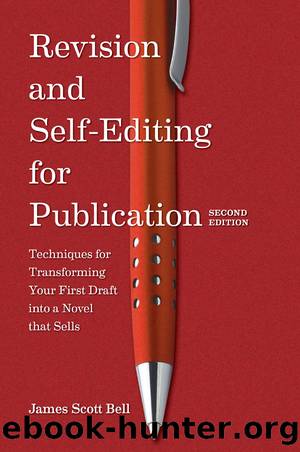Revision and Self Editing for Publication by James Scott Bell

Author:James Scott Bell [Scott Bell, James]
Language: eng
Format: epub
ISBN: 978-1-59963-710-5
Publisher: Penguin Publishing Group
Published: 2012-09-15T00:00:00+00:00
The Use and Abuse of Prologues
One of the most popular TV shows of the late 1950s to early 1960s was Peter Gunn. The series, starring Craig Stevens as a cool, jazz-loving private eye, didnât start with credits. It jumped right in with a shocking incident, usually somebody getting murdered. It lasted about two minutes.
Then the famous Henry Mancini opening theme burst on, with the credits. The rest of the show was about Gunnâs getting to the bottom of what happened. This was the proper use of a grabber prologue, because (1) it was short and dramatic in and of itself, and (2) it had something to do with the main plot.
Dean Koontzâs Midnight begins with a prologue (even though he calls it chapter one). It works for the following reasons.
The opening line:
Janice Capshaw liked to run at night.
Koontz begins many of his books this way, with a named character in motion and an intriguing detail. Running at night presages mystery.
As Janice runs, Koontz also gives us some details about Janice and the setting. Using mood details like light and fog, an ominous scene unfolds.
As she ran down the sloping main street, through pools of amber light, through layered night shadows caused by wind-sculpted cypresses and pines, she saw no movement other than her ownâand the sluggish, serpentine advance of the thin fog through the windless air.
Koontz also drops in backstory elements: a short paragraph about Janiceâs childhood, how darkness soothed her, and another about her late husband and how much she misses him.
With these small bits of backstory in place, the readerâs sympathy is with Janice as she jogs in the dark. Koontz spends the remainder of the chapter building the suspense of a horrific chase and, eventually, the stunning death of Janice Capshaw. The death has more impact because the background details bonded us, even briefly, to the character.
A prologue can be used to set up the story to come by giving us some essential history mixed with a tone of anticipation. The rather long prologue to Pat Conroyâs The Prince of Tides is like that. It gives the family background of the narrator, Tom Wingo, and his twin sister, Savannah, who has twice attempted suicide. The prologue wraps up thus:
The truth is this: Things happened to my family, extraordinary things. I know families who live out their entire destinies without a single thing of interest happening to them. I have always envied those families. The Wingos were a family that fate tested a thousand times and left defenseless, humiliated, and dishonored. But my family also carried some strengths into the fray, and these strengths let almost all of us survive the descent of the Furies. Unless you believe Savannah; it is her claim that no Wingo survived.
I will tell you my story.
Nothing is missing.
I promise you.
To write a prologue like that, style is important. The sound of the words and the mood created is what gives this prologue its power.
Download
This site does not store any files on its server. We only index and link to content provided by other sites. Please contact the content providers to delete copyright contents if any and email us, we'll remove relevant links or contents immediately.
| Publishing & Books | Research |
| Writing |
Asking the Right Questions: A Guide to Critical Thinking by M. Neil Browne & Stuart M. Keeley(5712)
Autoboyography by Christina Lauren(5206)
Eat That Frog! by Brian Tracy(4484)
Dialogue by Robert McKee(4357)
Sticky Fingers by Joe Hagan(4148)
Journeys Out of the Body by Robert Monroe(3593)
Annapurna by Maurice Herzog(3449)
Full Circle by Michael Palin(3419)
Schaum's Quick Guide to Writing Great Short Stories by Margaret Lucke(3349)
Elements of Style 2017 by Richard De A'Morelli(3325)
The Art of Dramatic Writing: Its Basis in the Creative Interpretation of Human Motives by Egri Lajos(3040)
Atlas Obscura by Joshua Foer(2934)
Why I Write by George Orwell(2917)
The Diviners by Libba Bray(2911)
In Patagonia by Bruce Chatwin(2897)
The Fight by Norman Mailer(2893)
The Mental Game of Writing: How to Overcome Obstacles, Stay Creative and Productive, and Free Your Mind for Success by James Scott Bell(2877)
Venice by Jan Morris(2550)
The Elements of Style by William Strunk and E. B. White(2454)
